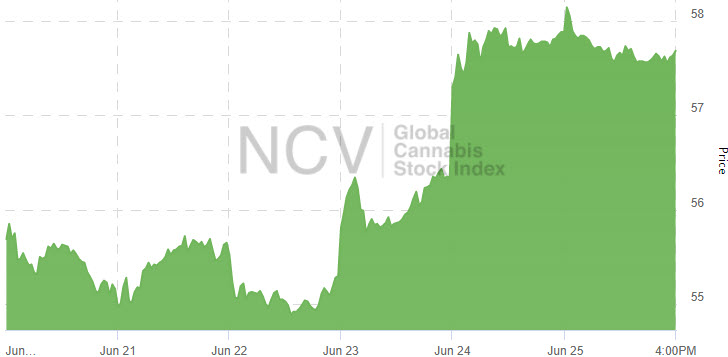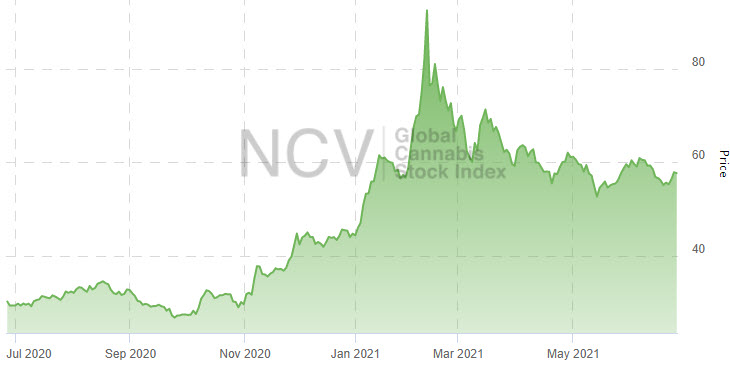Navigate the fast-moving cannabis sector with 420 Investor, a premium service that sends real-time alerts and explanations of the news below and much more.
Summary
- Michigan cannabis sales were soft in May, while Canadian sales picked up in April.
- Health Canada added 10 licenses, leaving the total now at 710.
- 420 Investor model portfolios have gained 48.1-89.0% year-to-date, while the Global Cannabis Stock Index has gained 29.9%.
Review
Michigan cannabis sales slipped 3% sequentially in May as the growth rate from a year ago fell sharply to 76%. Sales of $149 million were impacted by declining medical cannabis sales and falling prices for flower.
Canadian cannabis sales accelerated in April, increasing 4% sequentially and 74% from a year ago to $310 million. Health Canada added 10 licenses, leaving the total at 710, including 3 that are expired, revoked or suspended. It published data for March showing continued high levels of inventory in all product categories.
During the week, I shared these insights with subscribers at 420 Investor:
- Model Portfolio Composition 06/18/21
- Cannabis Sub-Sector Review – 06/18/21
- Agrify’s Grow Technology Addresses a Major Cannabis Industry Shortcoming
- Changes to the Global Cannabis Stock Index for July 2021
Here are some of this week’s highlights for 420 Investor Focus List names:
- CGC closed the acquisition of Supreme Cannabis
- CURLF opened its second NJ dispensary
- FFLWF received notification from Couche-Tard regarding the exercise of 10.5 million warrants
- HRVSF announced expiration of the HSR waiting period for its acquisition by Trulieve
- LQSIF announced a normal course issuer bid to buy back up to 10% of the shares outstanding
- OGI filed a preliminary base shelf to raise up to C$500 million
- PLNHF announced the opening of its California superstore, which will feature store-in-stores from Select and STIIZY
- TCNNF announced expiration of the HSR waiting period for its acquisition of Harvest Health and Recreation. It opened its 85th Florida dispensary.
The Global Cannabis Stock Index made up a lot of last week’s lost ground despite a lack of news, gaining 4.6% to 57.68:
 The index, which lost 34.1% in 2019 and lost 54.9% in 2018 after gaining 91.8% in 2017 and 88.8% in 2016, was up 5.2% in 2020. It has gained 29.9% in 2021 thus far. It currently includes 46 stocks and ended 2020 at 44.39:
The index, which lost 34.1% in 2019 and lost 54.9% in 2018 after gaining 91.8% in 2017 and 88.8% in 2016, was up 5.2% in 2020. It has gained 29.9% in 2021 thus far. It currently includes 46 stocks and ended 2020 at 44.39:
 Model Portfolios
Model Portfolios
420 Investor offers three model portfolios for subscribers, including two that are long-term focused and fully invested with a goal of beating the Global Cannabis Stock Index, 420 Opportunity and 420 Quality. 420 Opportunity ended the week valued at $167,094, up 2.9%. The model portfolio, up 58.6% in 2021, gained 35.6% in 2020 and has increased 234.2% since April 2014. 420 Quality ended the week at $239.184, up 2.9% for the week, and is now up 48.1% in 2021 after gaining 42.8% in 2020. The model was launched in March 2017 targeting long-term investors seeking to invest in leading cannabis stocks with low portfolio turnover and has gained 378.4% since inception compared to the 28.7% decrease in the index. Flying High, which is focused on swing trades, ended the week valued at $477,140, up 5.0%. The model portfolio gained 52.7% in 2020 and is up 89.0% in 2021, and the return since inception in late 2013 has been 4671%.
Outlook
After a strong rally to begin 2019, the cannabis sector experienced a sharp decline over the next year to unprecedented levels due to several negative developments, including the CannTrust fraud, the surprise termination of Bruce Linton as CEO of Canopy Growth, a disappointing roll-out of legalization in Canada, regulatory confusion in the U.S. regarding CBD and a slow roll-out of legalization in California, the vaping crisis and then financial turmoil and market disruptions due to the COVID-19 pandemic. The sector saw capital available to fund expansion dry up, a situation that continues to leave companies operating with negative cash flow severely challenged, as the availability is limited to stronger operators.
Cannabis stocks overreacted and put in a bottom in March 2020, and they are now benefiting from a perception that the industry offers strong growth prospects, something that wasn’t clear then. A big change has been that the pandemic caused many regulators to permit previously prohibited types of retail activities, like curbside pickup and delivery. The legal market is rapidly capitalizing on becoming even more convenient than the illicit market, with the ability to order online. High unemployment and large deficits have begun to spur state legalization efforts as well as more favorable regulatory control at the local level. Access to capital has improved dramatically, and the leading companies are generating large and rapidly growing revenue and profits.
There are several potential catalysts ahead, including the FDA providing clarity on CBD regulation, progress in the Canadian legalization that commenced in October 2018 and that is beginning to include a broader set of products and the continued growth in German and Israeli MMJ and other international markets that have been slow to develop. The adult-use implementations in California and Massachusetts for adult-use were slow to roll out but are beginning to show great improvement. Michigan and Illinois legalized for adult-use at the end of 2019, and these markets are showing strong growth that could encourage other states to legalize. Voters in Arizona, Montana, South Dakota and New Jersey all approved adult-use legalization in November, and New Mexico, New York and Virginia have enacted legalization through the legislative process in 2021.
The big themes ahead are likely to be continued cross-industry investment into the sector and more consolidation in Canada and in the U.S., potential federal regulatory reform (SAFE Banking Act and other more comprehensive legislation, which could eliminate 280E taxation and enable trading on higher exchanges for MSOs as well as the broad usage of credit cards for cannabis purchases), steps to enable cannabis research, the roll out of MMJ in Germany, Mexico and in Australia as well as continued advances in South America and potential adult-use legalization in Israel and Mexico, new legal cannabis implementations in AZ, MT, NJ and SD, and MMJ implementations in AL, WV and VA, possible legalization via the legislatures in DE, FL, MD, MN, NH, PA and RI and implementation of the CT, NM, NY and VT commercial programs in 2022 and VA in 2024.
After bottoming in March 2020, the cannabis sector has been in a new bull market. Many companies are generating substantial revenue and some even a profit, and liquidity is much better. The sector has transitioned away from many legacy penny stocks that had never proven that they had viable businesses towards better capitalized companies, many of which have strong management teams and substantial businesses. The investor base has also transitioned, becoming increasingly more institutional.
